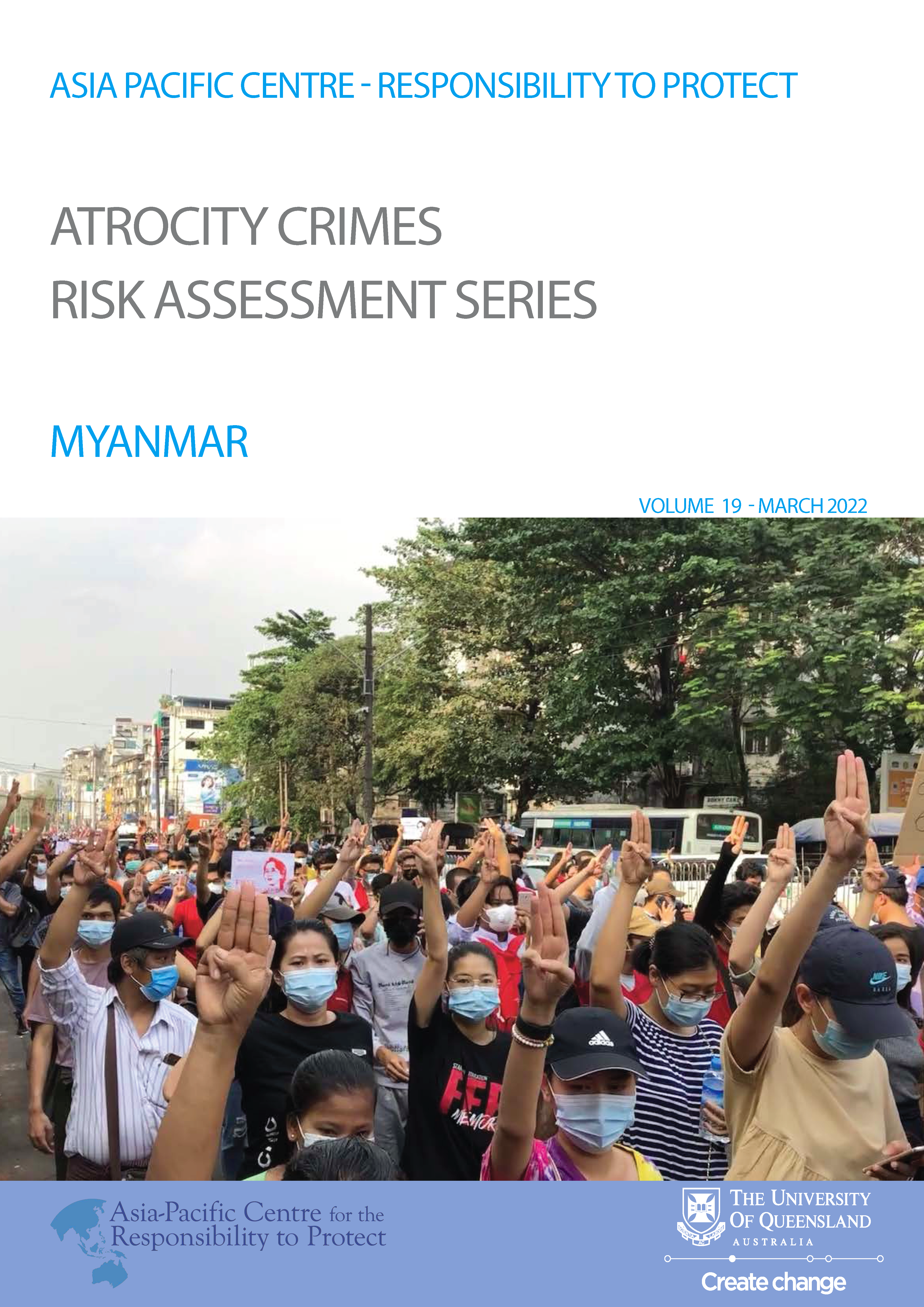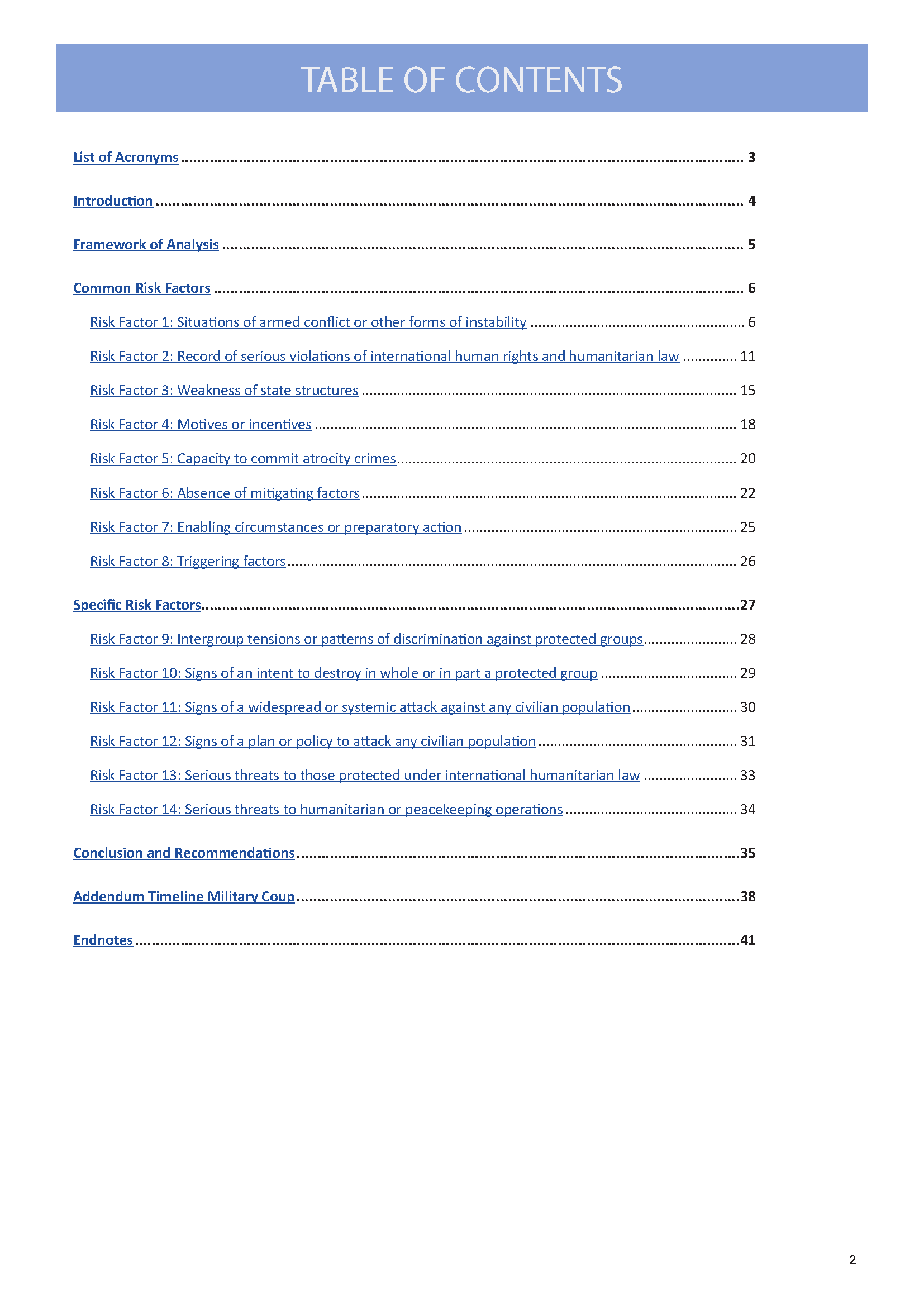ATROCITY CRIMES RISK ASSESSMENT SERIES – MYANMAR (VOLUME 19 – MARCH 2022)

Introduction
In 2005, the United Nations member states unanimously made a commitment to protect populations from the most serious crimes, namely genocide, war crimes, ethnic cleansing, and crimes against humanity.1 Known as the ‘Responsibility to Protect’ principle, or R2P, this commitment emphasises the primary responsibility by states to protect their own populations from these crimes, and the responsibility of the international community to support one another in their prevention.2 Recognising that atrocities are not random events but develop in a dynamic process and require the existence of an environment conducive to their occurrence, the United Nations Special Advisers on the Prevention of Genocide and the Responsibility to Protect developed a methodological framework in 2014 that enables the identification of warning signs indicating the existence of such circumstances. The Framework of Analysis for Atrocity Crimes (hereinafter ‘the framework’) sets out a series of Risk Factors and corresponding Indicators that enable stakeholders to identify high-risk developments in situations of serious human rights violations, domestic instability and crisis, pinpoint gaps in existing prevention capacities and promote necessary responses. The framework serves as a working tool for the monitoring and assessment of atrocity risks and as an early warning mechanism to support the prevention of their commission.3
The following atrocity crimes risk assessment applies the framework to the Republic of the Union of Myanmar (hereinafter ‘Myanmar’). It identifies the most pressing risk factors and provides recommendation on future steps that can be taken by relevant stakeholders to address risks of atrocities being committed.
Since the last atrocity risk assessment of the situation in Myanmar conducted in 2019, there have been significant domestic developments that have reshaped the climate for the commission of atrocity crimes in Myanmar. The risk of atrocity crimes, specifically crimes against humanity and war crimes, is very high and the risk of genocide remains high. The military coup d’état on 1 February 2021 has resulted in a large movement of civil disobedience, the establishment of a shadow government under the leadership of former NLD politicians and its formation of an armed resistance force. The brutal crackdown by the military in response to nationwide anti-junta protests has led many civilians to take up arms and join armed resistance forces. Renewed conflict between long-standing ethnic armed groups and the military, the emergence of new local armed militias, as well as violent clashes between the military and resistance forces have dragged the country into another civil war. The means and methods deployed by the Tatmadaw against political dissidents, civilians and members of the armed resistance already meet the threshold of crimes against humanity and war crimes but indicate the risk of further escalations of the situation.
These developments occur amidst a multi-dimensional economic and humanitarian crisis that has reached new records in unemployment rates and in the number of internally displaced people in dire need of humanitarian assistance. The global COVID-19 pandemic had severe impacts not only on an already buckling health sector, but has seen many people forced out of employment and into a state of severe food insecurity. The political unrest following the military coup, which resulted in an international response of targeted sanctions, withdrawal of foreign aid and foreign investment and an increase of unemployment across the entire country’s labour force, has caused a stagnation of Myanmar’s economy and pushed the country to the brink of an economic collapse. The large-scale disobedience movements in response to the coup, disruptions in supply chains as well as the junta’s regular shutdowns of telecommunication services, internet and power outages have paralysed essential sectors and much of the country’s infrastructure. In addition, atrocities committed against the Rohingya community during the military’s ‘clearance operations’ in Rakhine State in 2017 and 2018 remain unaddressed and have further nourished a climate of prevailing impunity and injustice. Hundreds of thousands of displaced Rohingya remain in detainment camps with restricted access of humanitarian aid delivery, while being denied freedoms of movement, access to basic goods, such as food and health care, and the right to a safe, dignified and voluntary return.
While the international community has stepped up its efforts to provide humanitarian aid to Myanmar, the UN and its member States remain divided over the political disputes over power. While the majority of States condemned the military coup and refuse to recognise the military junta as the legitimate government, international response to the military use of force has been limited to targeted sanctions against senior military leaders and the exclusion of its representatives from regional summits. A stronger engagement by key regional actors, such as ASEAN member States and their newly appointed Special Envoy, and a concerted response by international actors including the UN Security Council is required to put a halt to the excessive use of force by the military against the population, to delegitimise the military junta’s claim to power and assist the country in returning to its path towards a peaceful democratic transition that is capable of addressing past injustices and building a resilient and independent national State apparatus in conformity with international human rights standards.



